Experimental Study on the Influence of Temperature on the Mechanical Properties of Near-Space Airship Envelopes
Abstract
:1. Introduction
2. Methodology
3. Experiments
3.1. Experimental Material and Preparation
3.2. Verification of the Temperature Uniformity on the Specimen Surface
3.3. Analysis of the Influence of the Device on the Experiment
3.4. Analysis of the Influence of the Low-Temperature Alcohol Immersion Experience on the Specimens
3.5. Biaxial Tensile Test at Low Temperatures
4. Results and Discussion
5. Conclusions
- (1)
- At each temperature, the stress–strain curves of the UN-5100 membrane in the low-stress direction shows a complex nonlinear relationship.
- (2)
- The elastic modulus of UN-5100 membrane materials show a similar change trend with the temperature, but the warp elastic modulus is always greater than the weft direction under all temperature conditions.
- (3)
- The elastic modulus and Poisson ratio of the materials at low temperatures are larger than those at high temperatures. This means that in a high-temperature environment, the material’s tolerable strength is reduced and is more prone to tensile damage.
- (4)
- Under low-temperature conditions, the warp elastic modulus of the membrane materials increased by 27.2% compared with the normal temperature, and the weft elastic modulus increased by 23.57%. At 80 °C, the elastic modulus decreased with rising temperature: the warp elastic modulus decreased by 12.53% and the weft elastic modulus decreased by 12.85% compared with that at room temperature.
Author Contributions
Funding
Institutional Review Board Statement
Informed Consent Statement
Data Availability Statement
Conflicts of Interest
References
- Zhang, L.; Li, J.; Jiang, Y.; Du, H.; Zhu, W.; Lv, M. Stratospheric airship endurance strategy analysis based on energy optimization. Aerosp. Sci. Technol. 2020, 100, 105794. [Google Scholar] [CrossRef]
- Manikandan, M.; Pant, R.S. Design optimization of a tri-lobed solar powered stratospheric airship. Aerosp. Sci. Technol. 2019, 91, 255–262. [Google Scholar] [CrossRef]
- Tang, J.; Duan, D.; Xie, W. Shape Exploration and Multidisciplinary Optimization Method of Semirigid Nearing Space Airships. J. Aircr. 2022, 59, 946–963. [Google Scholar] [CrossRef]
- Tang, J.; Wang, X.; Duan, D.; Xie, W. Optimisation and analysis of efficiency for contra-rotating propellers for high-altitude airships. Aeronaut. J. 2019, 123, 706–726. [Google Scholar] [CrossRef]
- Tang, J.; Pu, S.; Yu, P.; Xie, W.; Li, Y.; Hu, B. Research on Trajectory Prediction of a High-Altitude Zero-Pressure Balloon System to Assist Rapid Recovery. Aerospace 2022, 9, 622. [Google Scholar] [CrossRef]
- Zhang, L.; Zhu, W.; Du, H.; Lv, M. Multidisciplinary design of high altitude airship based on solar energy optimization. Aerosp. Sci. Technol. 2021, 110, 106440. [Google Scholar] [CrossRef]
- Yang, Y.; Xu, X.; Zhang, B.; Zheng, W.; Wang, Y. Bionic design for the aerodynamic shape of a stratospheric airship. Aerosp. Sci. Technol. 2020, 98, 105664. [Google Scholar] [CrossRef]
- Gonzalo, J.; Domínguez, D.; García-Gutiérrez, A.; Escapa, A. On the development of a parametric aerodynamic model of a stratospheric airship. Aerosp. Sci. Technol. 2020, 107, 106316. [Google Scholar] [CrossRef]
- Xie, W.C.; Wang, X.L.; Duan, D.P.; Tang, J.W. Finite Element Simulation of the Microstructure of Stratospheric Airship Envelopes. AIAA J. 2020, 58, 3690–3699. [Google Scholar] [CrossRef]
- Li, D. Environment Control for Stratospheric Airship. Spacecr. Recovery Remote Sens. 2006, 51–56. [Google Scholar] [CrossRef]
- Cheng, C. Transient Thermal Model and Thermal Characteristics Analysis of Near-Space Airships. Master’s Thesis, Shanghai Jiao Tong University, Shanghai, China, 2019. [Google Scholar]
- Wang, X.; Xie, W. Thermal Characteristics Analysis of Stratospheric Airships Envelope. Equip. Environ. Eng. 2020, 1, 13–19. [Google Scholar]
- Tang, J.; Xie, W.; Wang, X.; Chen, C. Simulation and Analysis of Fluid–Solid–Thermal Unidirectional Coupling of Near-Space Airship. Aerospace 2022, 9, 439. [Google Scholar] [CrossRef]
- Kang, W.; Suh, Y.; Woo, K.; Lee, I. Mechanical property characterization of film-fabric laminate for stratospheric airship envelope. Compos. Struct. 2006, 75, 151–155. [Google Scholar] [CrossRef]
- Maekawa, S.; Shibasaki, K.; Kurose, T.; Maeda, T.; Sasaki, Y.; Yoshino, T. Tear Propagation of a High-Performance Airship Envelope Material. J. Aircr. 2015, 45, 1546–1553. [Google Scholar] [CrossRef]
- Yamamoto, Y.; Nakagawa, J. 14The structure and properties of high-modulus, high-tenacity Vectran fibres. In Handbook of Textile Fibre Structure; Woodhead Publishing: Sawston, UK, 2009; pp. 413–428. [Google Scholar]
- McDaniels, K.; Downs, R.; Meldner, H.; Beach, C.; Adams, C. High Strength to Weight Ratio Non Woven Technical Fabrics for Aerospace Applications. In Proceedings of the AIAA Balloon Systems Conference, Seattle, DC, USA, 4–7 May 2009. [Google Scholar] [CrossRef]
- Xianghong, B. Research on the Evolution of Mechanical Properties of Airship Envelopes. Ph.D. Thesis, Harbin Institute of Technology, Harbin, China, 2009. [Google Scholar]
- Ambroziak, A.; Klosowski, P. Mechanical testing of technical woven fabrics. J. Rnforced Plast. Compos. 2013, 32, 726–739. [Google Scholar] [CrossRef]
- Komatsu, K.; Sano, M.A.; Kakuta, Y. Development of High Specific Strength Envelope Materials. J. Jpn. Soc. Aeronaut. Space Sci. 2013, 51, 158–163. [Google Scholar]
- Xie, W.; Wang, X.; Duan, D.; Tang, J.; Wei, Y. Mechanical properties of UN-5100 envelope material for stratospheric airship. Aeronaut. J. New Ser. 2020, 125, 472–488. [Google Scholar] [CrossRef]
- Tang, J.; Xie, W.; Wang, X.; Chen, Y.; Wu, J. Study of the Mechanical Properties of Near-Space Airship Envelope Material Based on an Optimization Method. Aerospace 2022, 9, 655. [Google Scholar] [CrossRef]
- Bridgens, B.; Gosling, P. Interpretation of results from the MSAJ Testing Method for Elastic Constants of Membrane Materials. Tensinet Symp. 2010, 2020, 49–57. [Google Scholar]
- MSAJ/M-02-1995; Testing Method for Elastic Constants of Membrane Materials. Membrane Structures Association of Japan: Tokyo, Japan, 1995.
- Shaeffer, R.E. Tensioned Fabric Structure-A Practical Introduction; American Society of Civil Engineers: New York, NY, USA, 1996. [Google Scholar]
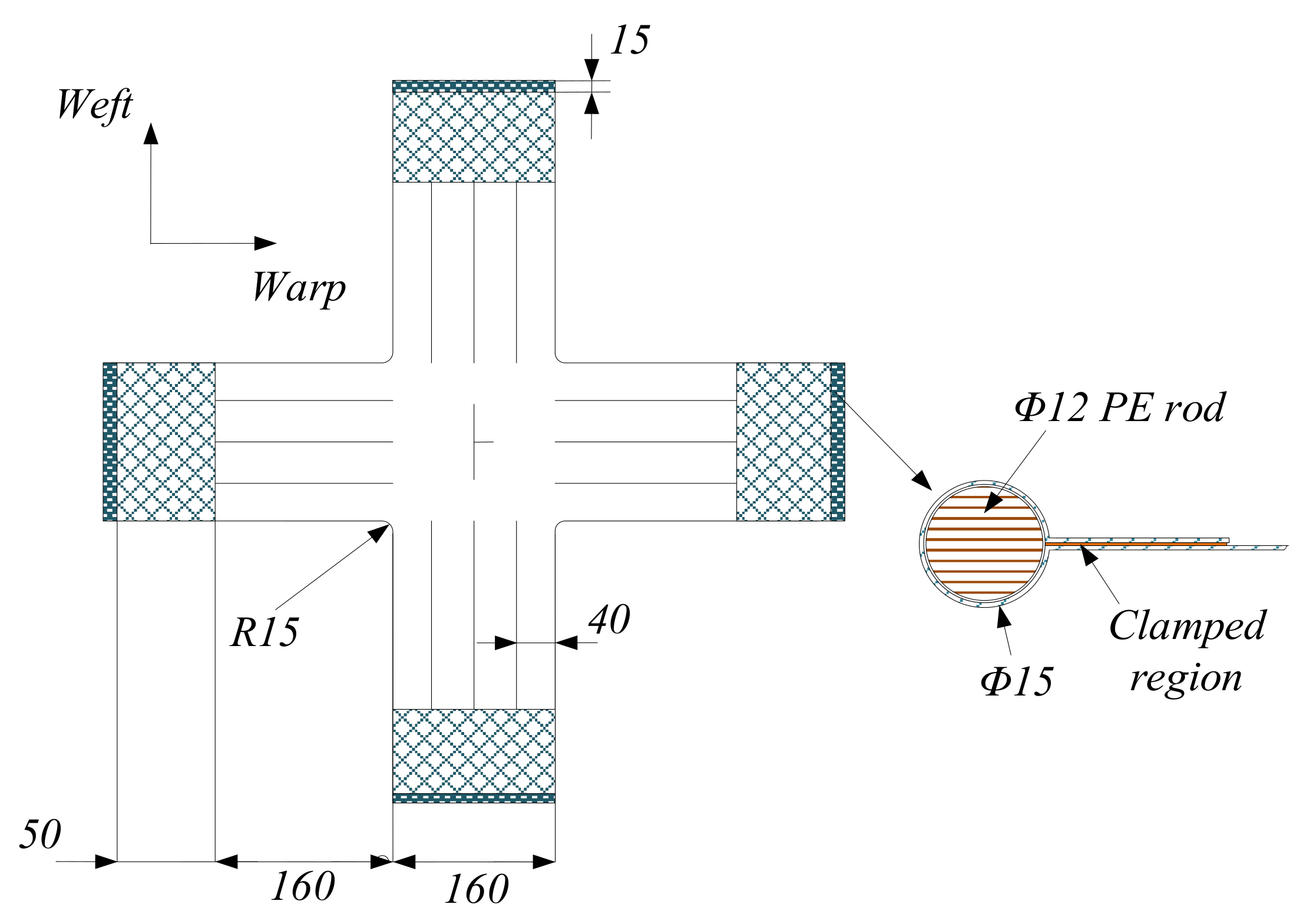
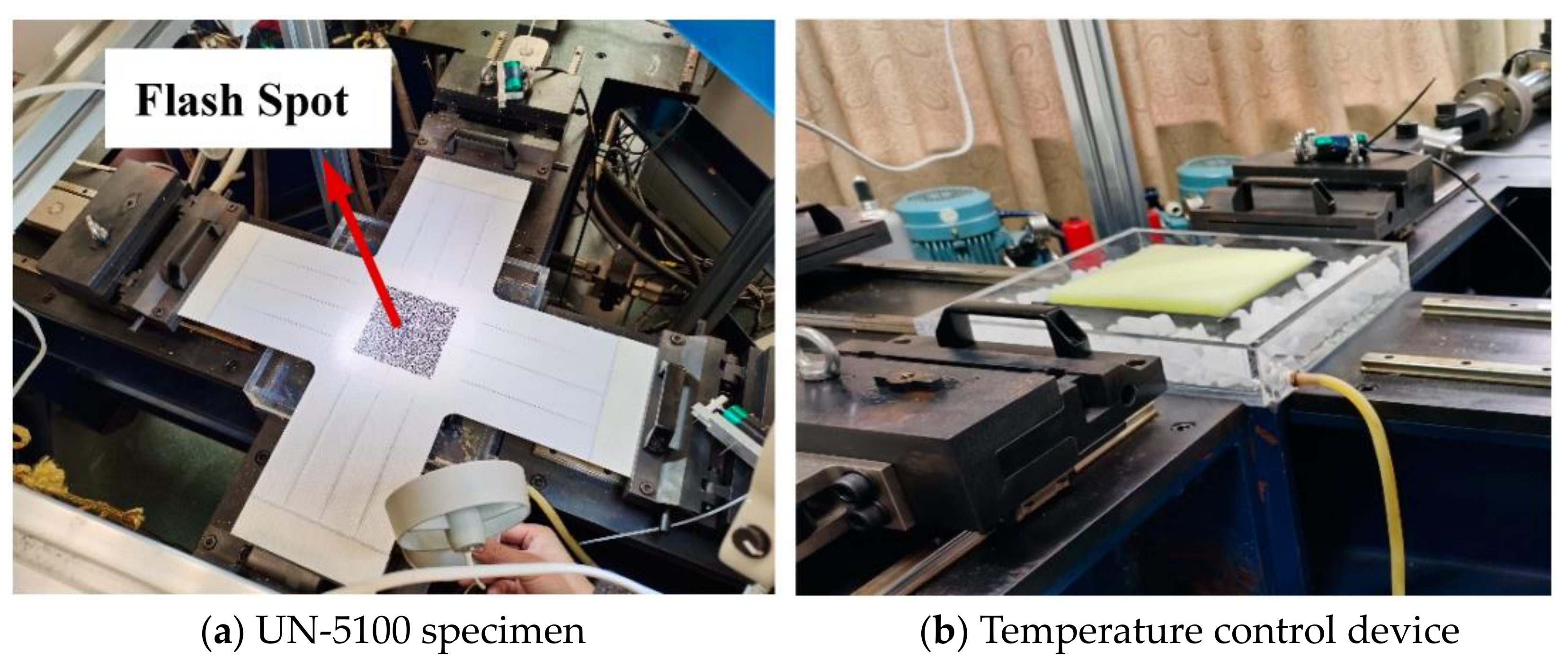
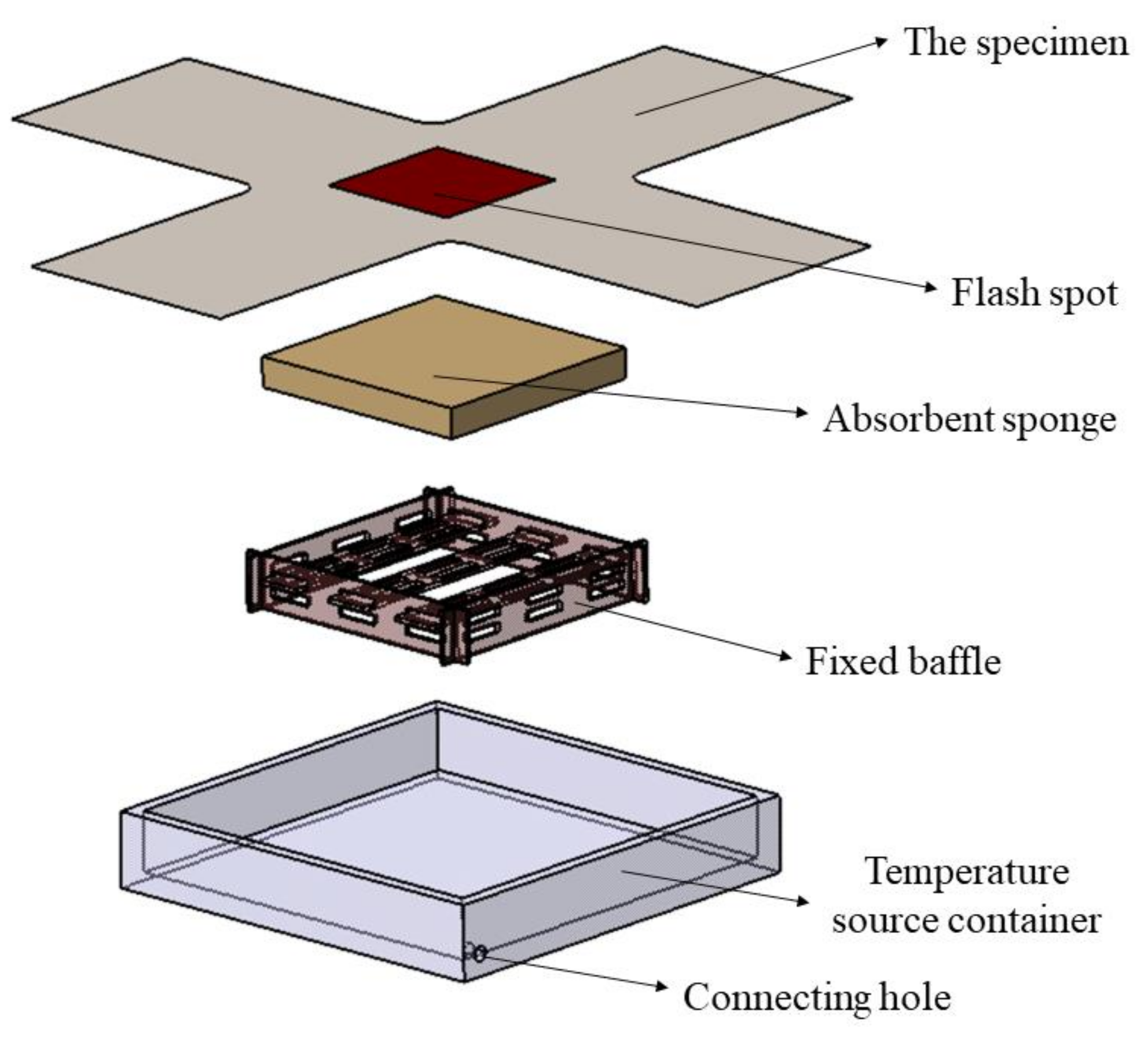
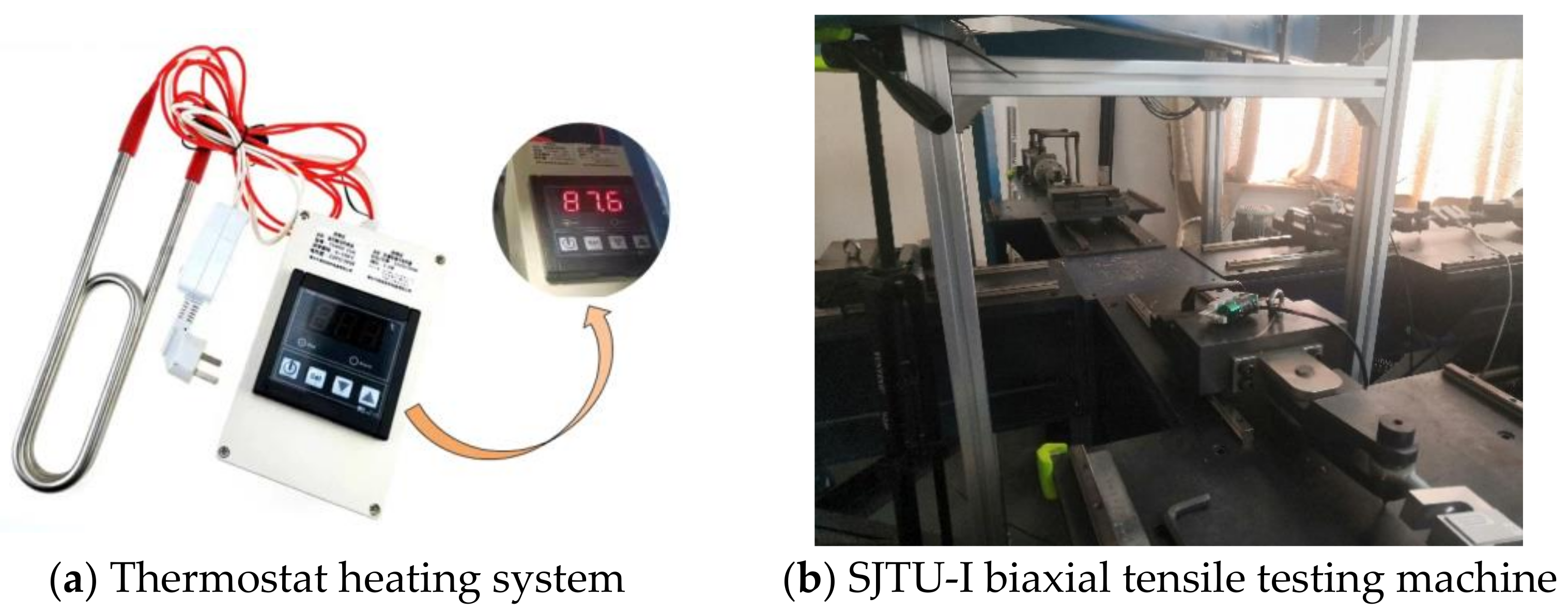

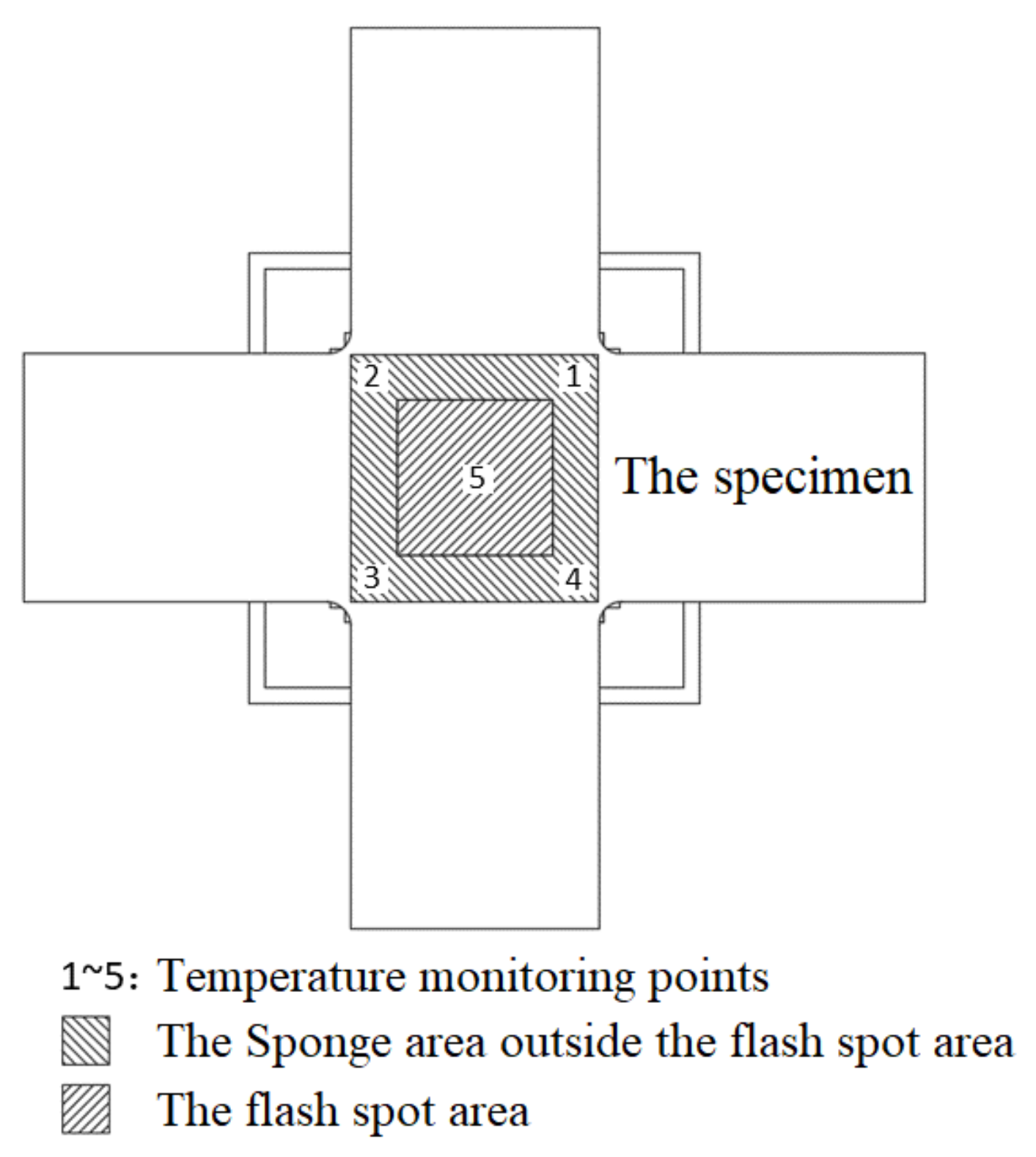

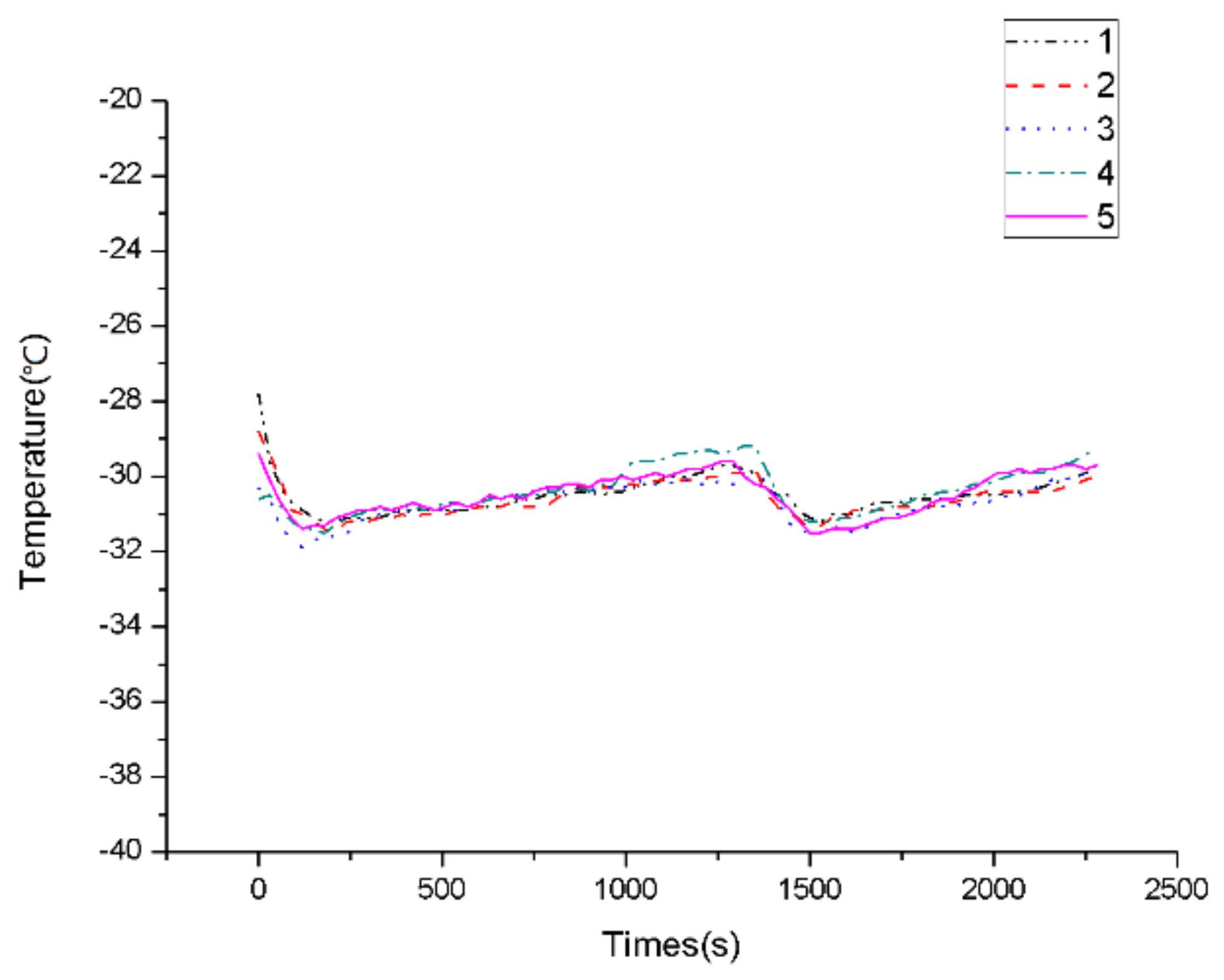
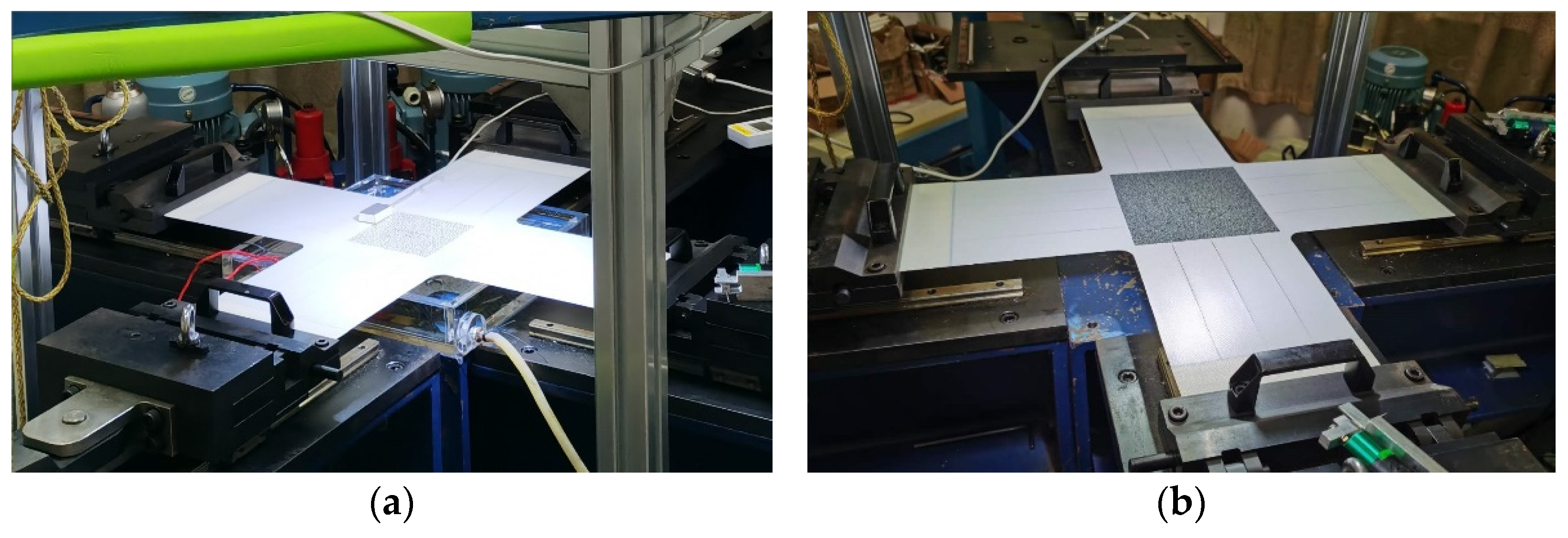
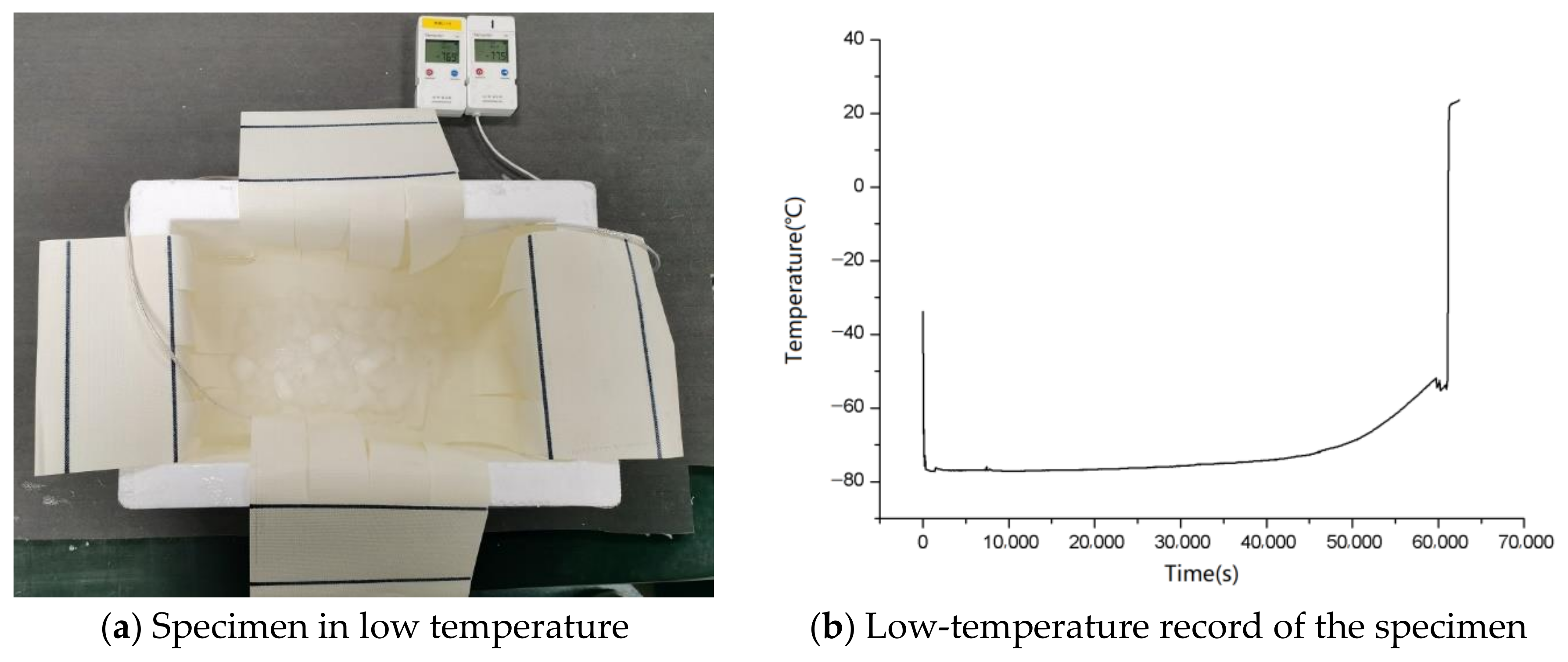
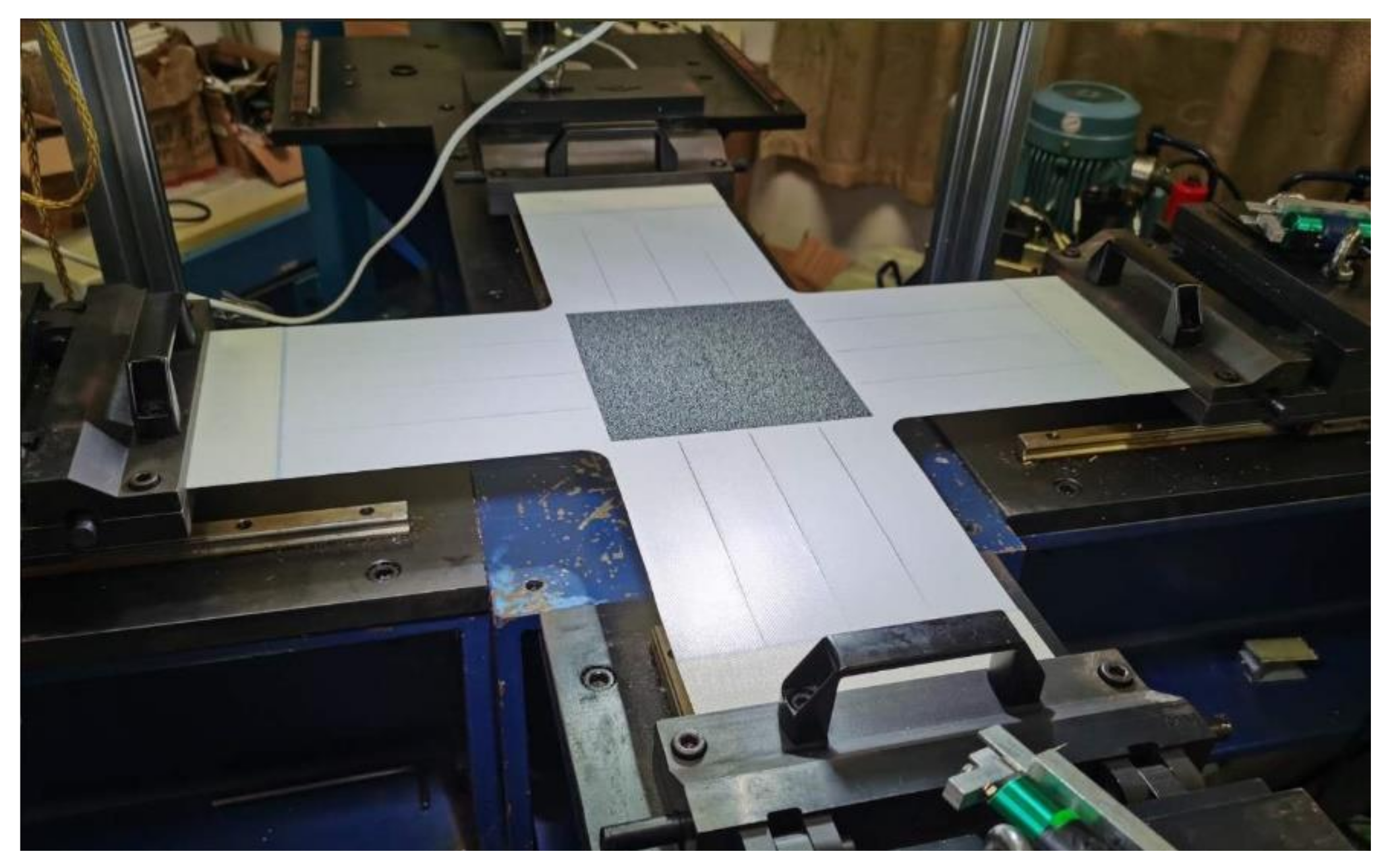

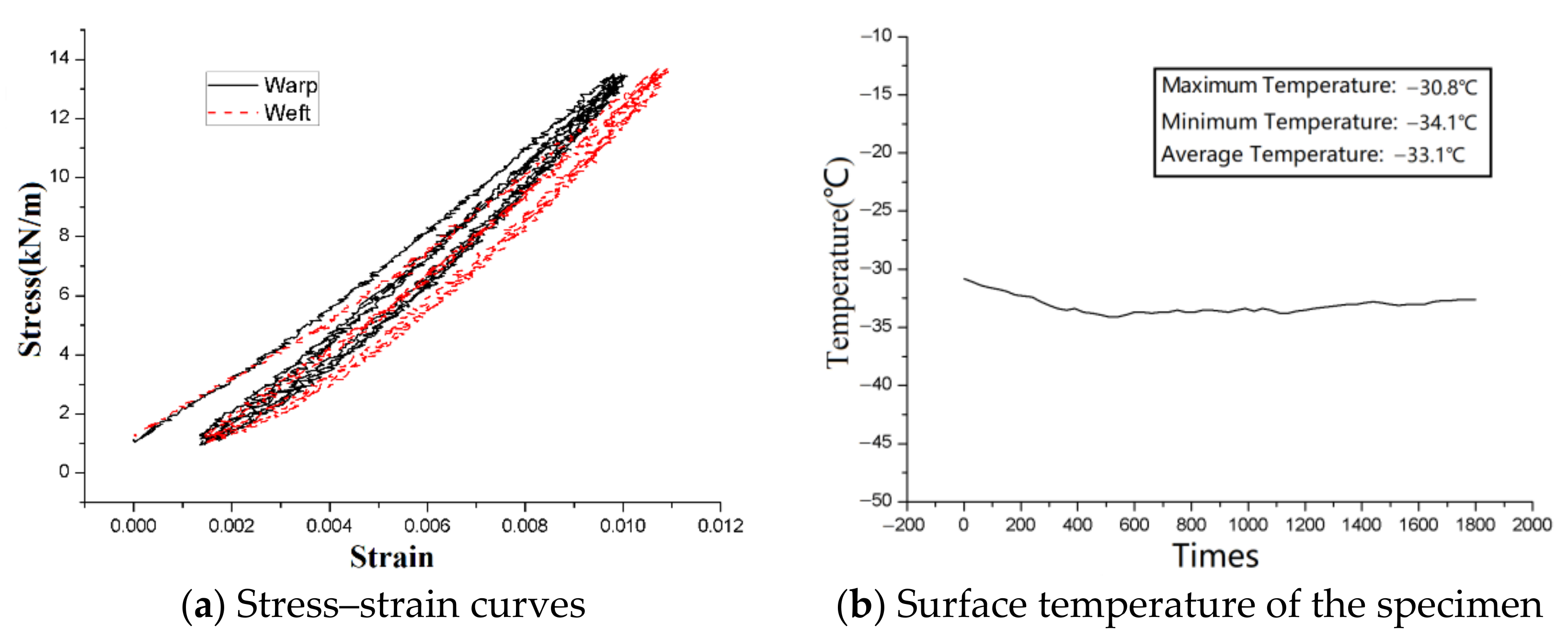
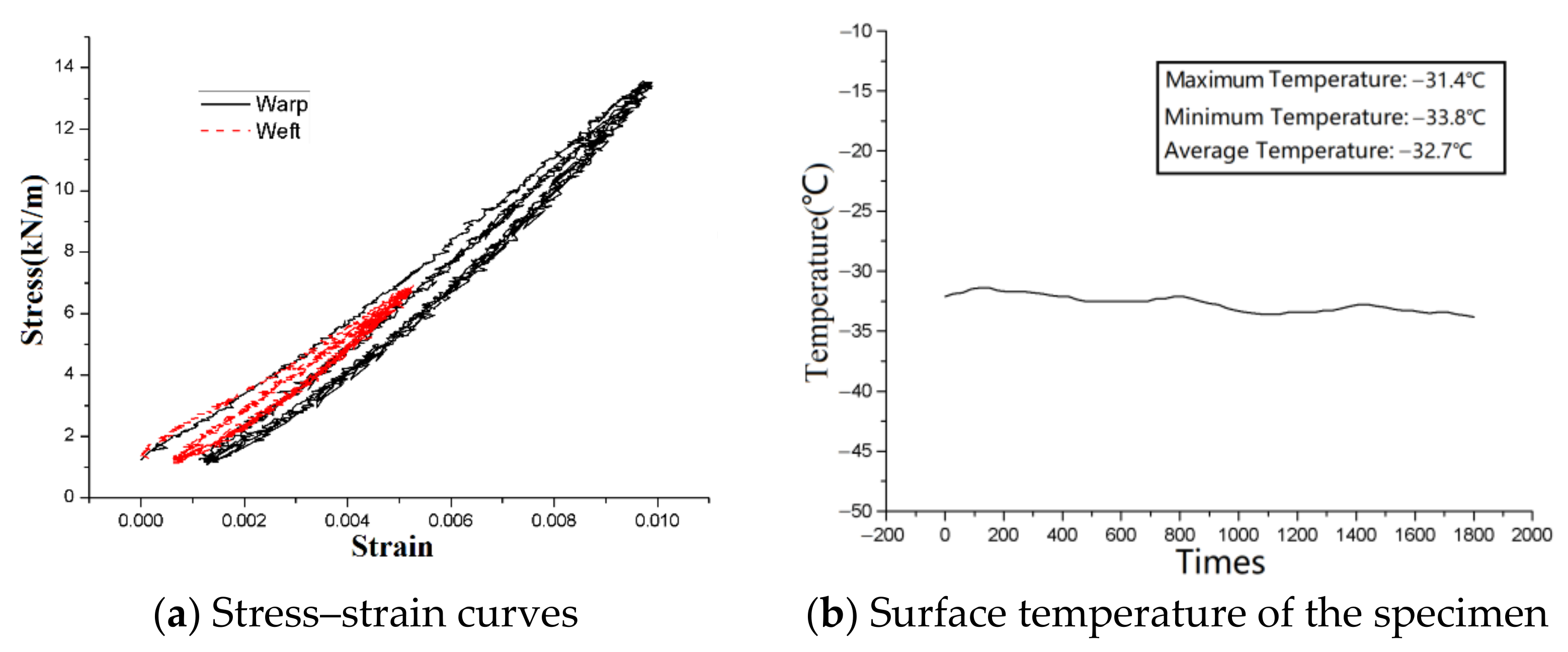

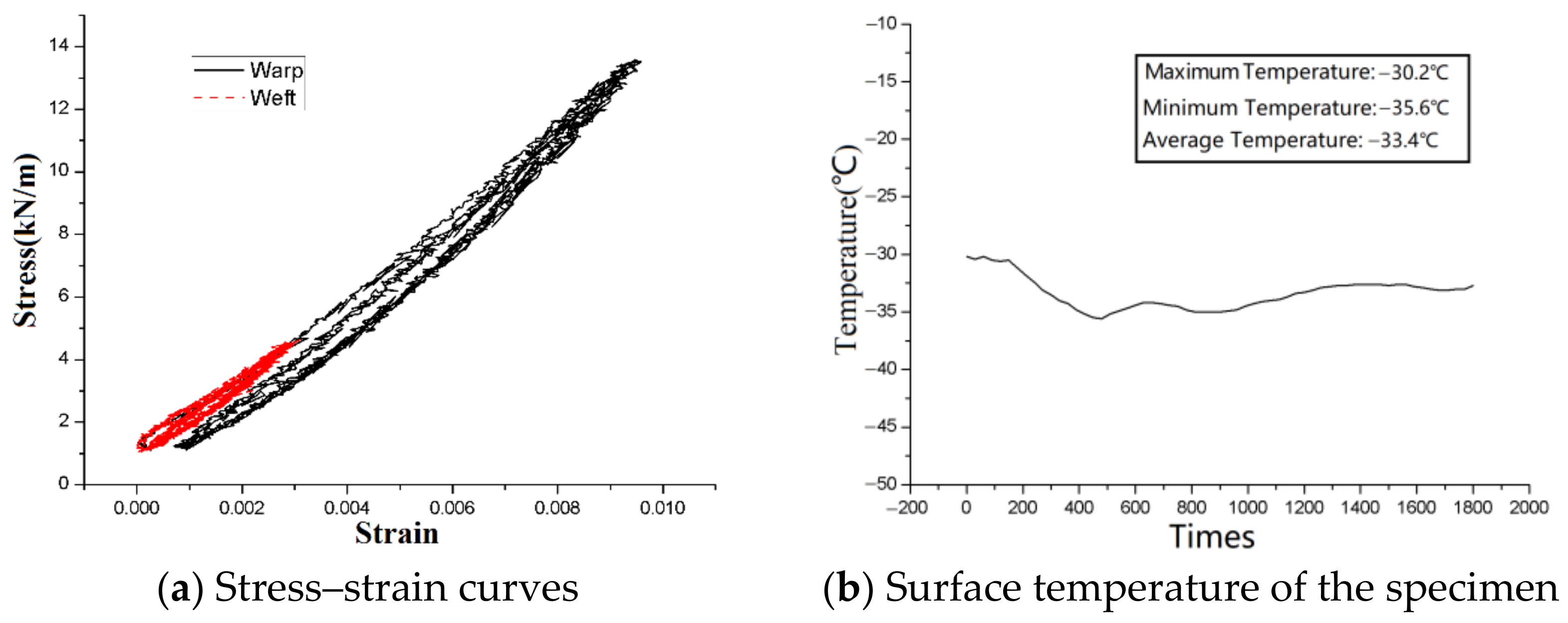


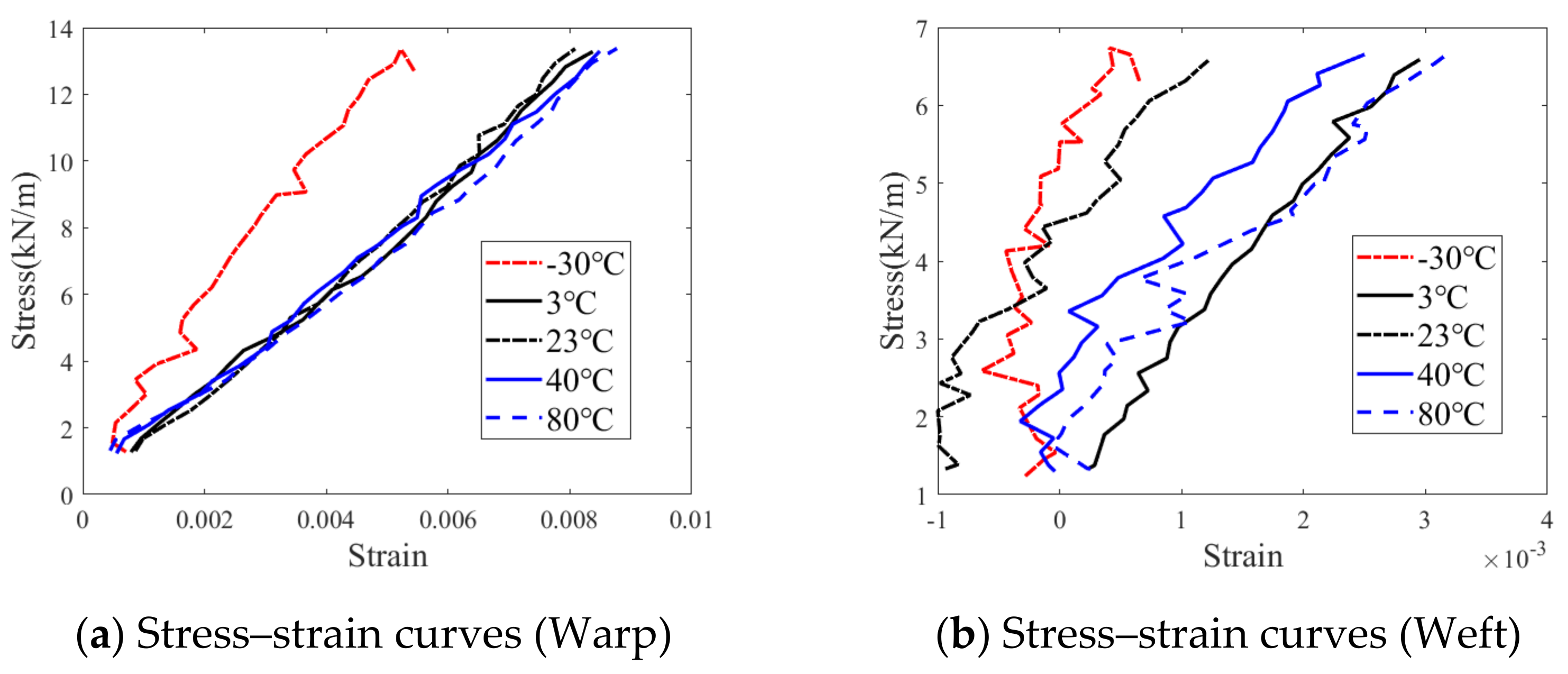
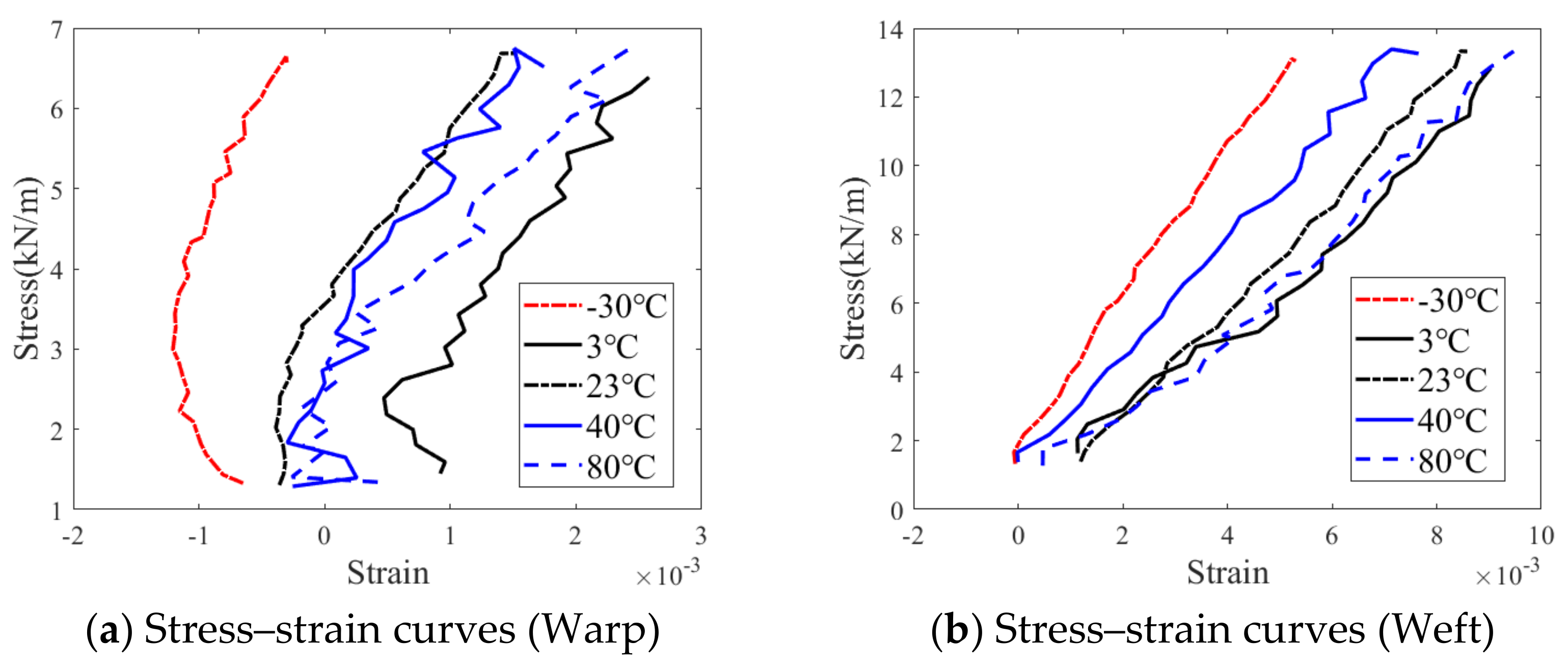

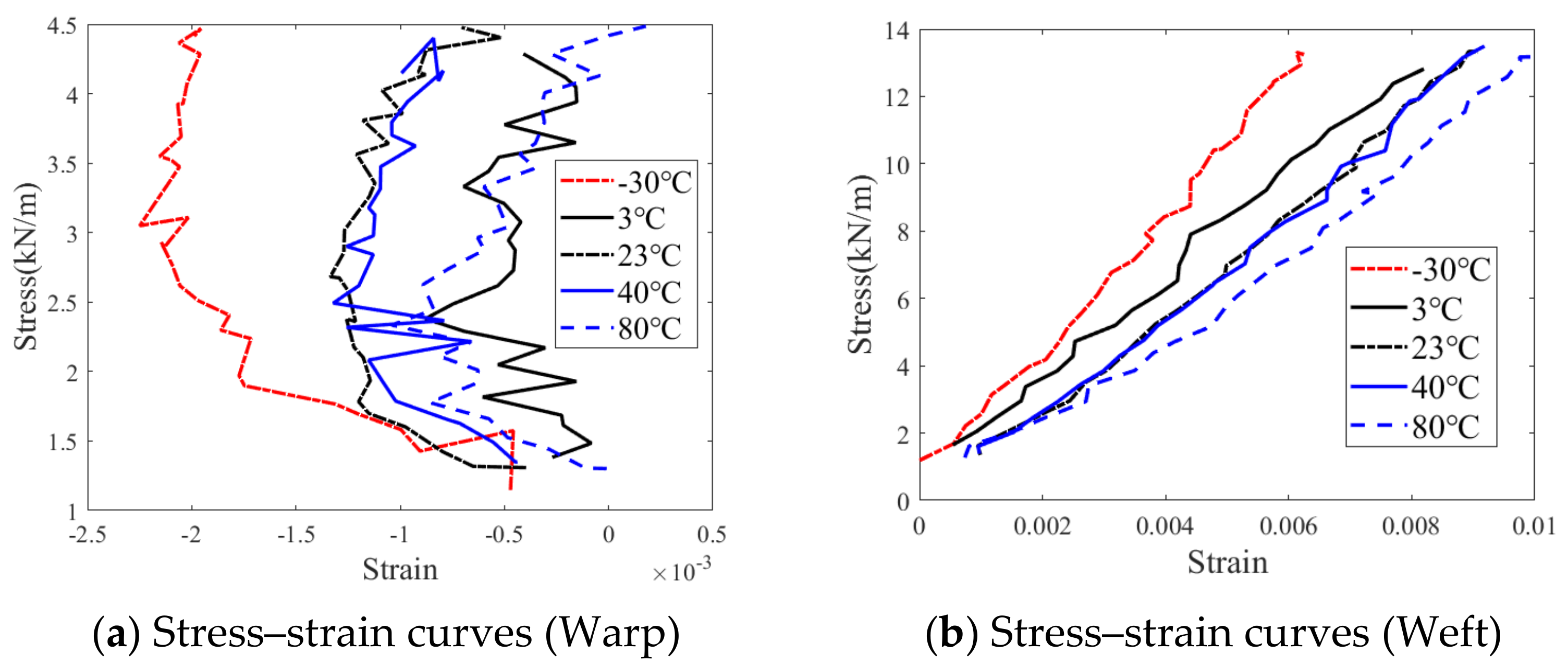
| Poisson’s Ratio | ||||
|---|---|---|---|---|
| Without the temperature control device | 13.97 | 13.15 | 0.215 | 0.203 |
| With the temperature control device | 14.11 | 13.27 | 0.217 | 0.204 |
| Poisson’s Ratio | ||||
|---|---|---|---|---|
| The specimen at 23 °C | 13.97 | 13.15 | 0.215 | 0.203 |
| The specimen after the low-temperature treatment | 14.23 | 12.99 | 0.209 | 0.215 |
| Temperature | Elastic Modulus | Elastic Modulus | Poisson’s Ratio | Poisson’s Ratio |
|---|---|---|---|---|
| (°C) | ||||
| −33 °C | 17.77 | 16.26 | 0.381 | 0.348 |
| 3 °C | 14.55 | 14.01 | 0.223 | 0.242 |
| 23 °C | 13.97 | 13.15 | 0.215 | 0.203 |
| 40 °C | 13.07 | 12.91 | 0.228 | 0.225 |
| 80 °C | 12.22 | 11.46 | 0.199 | 0.187 |
Disclaimer/Publisher’s Note: The statements, opinions and data contained in all publications are solely those of the individual author(s) and contributor(s) and not of MDPI and/or the editor(s). MDPI and/or the editor(s) disclaim responsibility for any injury to people or property resulting from any ideas, methods, instructions or products referred to in the content. |
© 2023 by the authors. Licensee MDPI, Basel, Switzerland. This article is an open access article distributed under the terms and conditions of the Creative Commons Attribution (CC BY) license (https://creativecommons.org/licenses/by/4.0/).
Share and Cite
Xie, W.; Wang, X.; Tang, J.; Chen, Y.; Wu, J. Experimental Study on the Influence of Temperature on the Mechanical Properties of Near-Space Airship Envelopes. Aerospace 2023, 10, 413. https://doi.org/10.3390/aerospace10050413
Xie W, Wang X, Tang J, Chen Y, Wu J. Experimental Study on the Influence of Temperature on the Mechanical Properties of Near-Space Airship Envelopes. Aerospace. 2023; 10(5):413. https://doi.org/10.3390/aerospace10050413
Chicago/Turabian StyleXie, Weicheng, Xiaoliang Wang, Jiwei Tang, Yonglin Chen, and Junjie Wu. 2023. "Experimental Study on the Influence of Temperature on the Mechanical Properties of Near-Space Airship Envelopes" Aerospace 10, no. 5: 413. https://doi.org/10.3390/aerospace10050413





